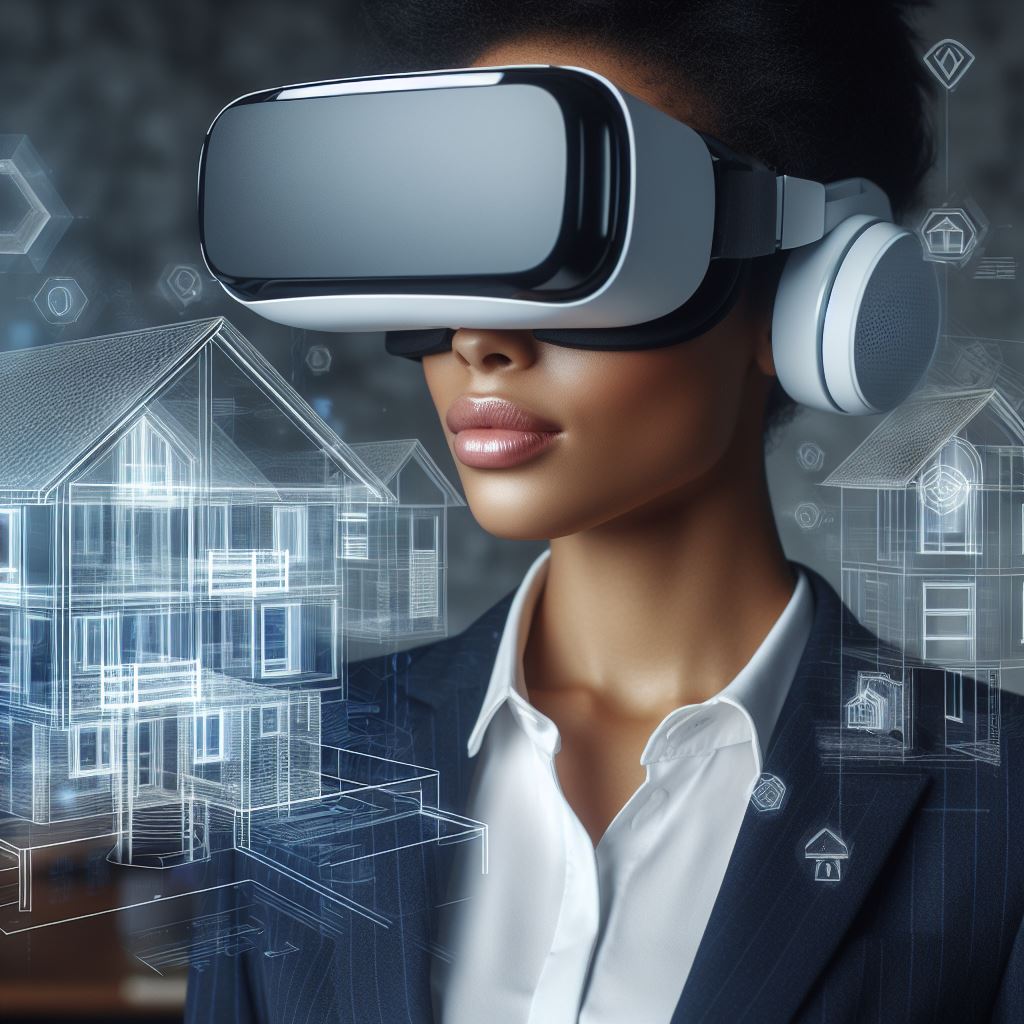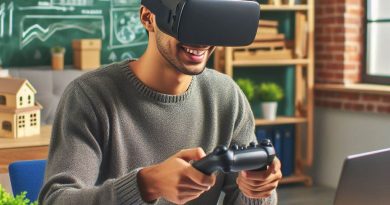Experience Architecture with VR
Last Updated on February 6, 2024
Introduction
Architecture plays a crucial role in creating immersive experiences for users.
It is not just about designing buildings but about creating spaces that evoke emotions and engage the senses.
Virtual reality (VR) technology is an increasingly popular tool used in architecture to provide immersive experiences.
It enables users to explore and interact with virtual environments in a realistic and lifelike manner.
Using VR to experience architecture has several benefits.
It allows users to visualize and experience a space before it is built, resulting in better-informed design decisions.
VR also enables architects to test different design options and gather feedback from clients and users.
Virtual reality provides a highly interactive and engaging experience, allowing users to walk through virtual environments, examine every detail, and experience the scale and proportions of a space.
It also enables architects to showcase their designs to clients in a more compelling and experiential way.
Additionally, VR can be used as a powerful educational tool, allowing students and professionals to learn about architecture and design principles by immersing themselves in virtual spaces.
In essence, VR technology offers a transformative approach to experience architecture.
It enhances design processes, facilitates better communication, and provides a more immersive and engaging experience for users.
With the continued advancement of VR technology, the possibilities for creating extraordinary architectural experiences are endless.
Understanding Virtual Reality
Definition and explanation of VR
Virtual Reality (VR) refers to a simulated experience that can be similar to or completely different from the real world.
It immerses the user into a computer-generated environment, stimulating their senses through various devices.
VR creates a sensation of being present in a different place, allowing users to interact with the virtual world.
Types of virtual reality experiences
There are several types of VR experiences designed to cater to different needs and preferences.
- Non-Immersive VR: Users interact with the virtual environment on a screen without feeling fully immersed.
- Semi-Immersive VR: Users experience partial immersion through devices like headsets and handheld controllers.
- Fully Immersive VR: Users are completely immersed, utilizing headsets and other advanced equipment for a realistic experience.
Each type offers unique levels of immersion, making VR adaptable to various applications and industries.
How VR is used in various industries
- Gaming and Entertainment: VR gaming transports players into virtual worlds, providing deeply immersive experiences.
- Healthcare: VR is used for therapeutic purposes, such as treating phobias, post-traumatic stress disorder, and pain management.
- Education: VR enables interactive and immersive learning experiences, allowing students to explore complex concepts.
- Architecture and Design: Architects and designers can visualize and modify structures in a realistic virtual environment.
- Training and Simulations: VR replicates real-life scenarios for training purposes, reducing costs and potential risks.
These are just a few examples of how VR has revolutionized various industries, enhancing efficiency and creativity.
Current advancements in VR technology
- Improved Visuals: High-resolution displays and advancements in graphic processing enhance the visual quality of VR experiences.
- Enhanced Interactivity: Advanced motion tracking and gesture recognition technologies provide more intuitive interactions.
- Haptic Feedback: Haptic devices deliver touch sensations, making VR experiences even more realistic and immersive.
- Wireless VR: Advancements in wireless technology allow for more freedom of movement during VR experiences.
- Social VR: Collaborative VR experiences enable users to interact with others in the virtual world, enhancing social connections.
With these advancements, VR is becoming more accessible, affordable, and impactful than ever before.
It has the potential to transform how we live, work, learn, and entertain, paving the way for a new era of experience architecture with VR.
Read: AI in Real Estate: Transforming Property Management
Exploring Architecture through VR
Using VR to visualize and walk through architectural designs
Virtual reality (VR) technology has revolutionized the way architects create and present their designs.
With VR, architects can now create immersive experiences where clients can visualize and even walk through a building before it is even constructed.
The use of VR in the architectural design process allows architects to give clients a realistic sense of scale, space, and design elements.
This helps clients to better understand the design and make more informed decisions before construction begins.
Architects can create virtual environments that accurately represent the real-world conditions of a project, including lighting, textures, and materials.
Clients can explore these virtual spaces using VR headsets, which provide a fully immersive experience.
By using VR, architects can also easily make changes to the design in real-time.
Clients can provide feedback and architects can make updates to the virtual model, allowing for a more iterative and collaborative design process.
Benefits of experiencing architecture in a virtual environment
Experiencing architecture through VR offers numerous benefits for both architects and clients.
- Design visualization: VR allows architects to visually communicate their ideas better than traditional 2D drawings or computer renderings.
- Client engagement: VR immerses clients in a virtual space, allowing them to fully experience and engage with the design.
- Realistic sense of scale: VR provides an accurate representation of the size and proportions of a building, helping clients understand spatial relationships.
- Easier decision-making: Clients can make more informed decisions by experiencing the design firsthand and exploring different options.
- Cost and time savings: VR eliminates the need for physical models, reducing costs and saving time in the design process.
Examples of VR applications in architectural design and education
VR has already been successfully applied in various architectural projects and educational settings.
- Design presentations: Architects can use VR to present their designs to clients, allowing them to walk through the virtual space and experience it firsthand.
- Public engagement: VR can be used to engage the public in the design process, allowing them to provide feedback and opinions.
- Virtual tours: Virtual tours of existing buildings or historical sites can be created using VR, providing an immersive and educational experience.
- Training and education: VR can be utilized as a teaching tool for architecture students to explore and understand complex spatial relationships.
- Collaborative design: Architects from different locations can collaborate on a project using VR, enabling them to work together in a shared virtual environment.
In fact, VR has revolutionized the architectural design process, providing architects and clients with a more immersive and collaborative experience.
By visualizing and walking through designs in a virtual environment, clients can better understand and engage with the proposed architecture.
The benefits of experiencing architecture through VR are numerous, including improved design visualization, client engagement, and cost savings.
With VR applications becoming more widespread, the future of architecture is likely to be increasingly intertwined with virtual reality technology.
Read: Building the Future: AR in Construction
Enhancing the Architectural Experience
Immersive simulations using VR technology
Virtual Reality (VR) technology is revolutionizing the way architects design and experience spaces.
Architects can now create immersive simulations that allow users to feel like they are walking through a building.
By putting on a VR headset, architects can transport themselves and their clients into the virtual world they have created.
This immersive experience helps architects and clients better understand the spatial relationships within a design.
Incorporating interactive elements in virtual architectural experiences
VR technology not only provides a realistic visual experience but also allows for interaction with virtual architectural elements.
Users can manipulate objects, open doors, and even change materials and finishes within the virtual environment.
This interactive capability gives architects and clients a hands-on experience that traditional 2D drawings and models cannot provide.
It enables them to test different design options and make more informed decisions about the final design.
Utilizing VR to enhance understanding of architectural concepts
VR technology also allows architects to enhance the understanding of architectural concepts for clients, builders, and other stakeholders.
Instead of trying to imagine how a space will look and feel based on floor plans and elevations, stakeholders can experience it firsthand.
This reduces miscommunication and ensures that everyone involved has a clear and shared vision of the design.
Moreover, VR can help architects communicate complex spatial relationships and design intentions more effectively.
VR’s impact on architectural design and decision-making processes
The use of VR in architectural design has a significant impact on the decision-making process.
Architects can make design iterations more efficiently by quickly creating and modifying virtual models.
They can experiment with different design options and evaluate their impact in real-time, saving time and resources.
VR technology also enables architects to present their designs in a more compelling and persuasive manner.
Clients and stakeholders can experience the design firsthand, increasing their confidence and trust in the architect’s abilities.
In short, the integration of VR technology in architecture enhances the overall architectural experience.
It allows architects to create immersive simulations, incorporate interactive elements, and enhance understanding of architectural concepts.
Furthermore, VR technology accelerates the architectural design process and improves decision-making through realistic virtual models.
Architects should embrace this technology to revolutionize their practice and deliver exceptional design experiences.
Read: The Rise of AR in Home Renovations

VR Tools and Platforms for Architects
Overview of popular VR tools and platforms
- Oculus Rift: High-quality VR headset that offers an immersive experience with stunning visuals and precise motion tracking.
- HTC Vive: Another top-notch VR headset that provides an immersive experience with room-scale tracking and realistic graphics.
- Google Cardboard: Affordable VR platform that allows users to experience virtual reality using their smartphones.
- Samsung Gear VR: A mobile-based VR platform that offers a wide range of VR applications and games.
Features and capabilities of VR tools designed for architects
- Realistic visualization: VR tools provide architects with the ability to visualize their designs in a realistic, immersive environment.
- Interactive design: Architects can use VR tools to modify and interact with their designs in real-time, allowing for better design iterations.
- Scale and proportion evaluation: VR tools enable architects to evaluate the scale and proportion of their designs by experiencing them firsthand.
- Client presentations: VR tools allow architects to create virtual walkthroughs of their designs, enhancing client presentations.
Considerations when choosing a VR tool for architectural purposes
- Compatibility: Ensure that the VR tool is compatible with your existing software and hardware.
- Ease of use: Choose a VR tool that has a user-friendly interface and intuitive controls.
- Software integration: Look for VR tools that seamlessly integrate with popular architectural software platforms.
- Cost: Consider the cost of the VR tool, including any additional hardware or software requirements.
- Support and updates: Check if the VR tool offers regular updates and technical support for troubleshooting.
Overall, VR tools and platforms have revolutionized the architecture industry, allowing architects to experience their designs in a whole new way.
With realistic visualization, interactive design capabilities, and the ability to create virtual walkthroughs, VR tools provide architects with valuable tools for design evaluation and client presentations.
When choosing a VR tool, architects should consider compatibility, ease of use, software integration, cost, and support to ensure a seamless VR experience.
Read: Top 10 Property Management Software of 2024
Future Trends and Possibilities
Emerging technologies and their potential impact on VR in architecture
- Artificial Intelligence (AI) can enhance VR experiences by creating personalized and adaptive virtual environments.
- Internet of Things (IoT) integration with VR can enable real-time data visualization for better decision-making in design.
- Augmented Reality (AR) can complement VR, allowing architects to overlay virtual objects onto real-world environments.
- 3D printing advancements can enable the creation of physical models based on virtual designs, enhancing the iterative design process.
- Advancements in haptic technology can provide tactile feedback in VR, improving the sense of touch and immersion.
Predictions for the future of VR in architecture and design
- VR will become an essential tool for architects, enabling immersive design reviews and client presentations.
- VR simulations will allow architects to test and refine designs before construction, reducing errors and costs.
- Virtual walkthroughs and tours will become common, offering clients a realistic preview of their future spaces.
- Collaborative VR platforms will facilitate global design teams to work together seamlessly, overcoming geographical boundaries.
- VR will empower users to customize and personalize their environments, creating tailored experiences for each individual.
Integration of VR with other technologies in creating experiential architecture
VR has the potential to integrate with various technologies, revolutionizing the creation of experiential architecture.
- VR and AI integration can enable dynamic and intelligent virtual environments that adapt to users’ preferences.
- IoT integration can gather real-time data from buildings and visualize it in VR, aiding architects in optimizing energy efficiency.
- AR integration can enhance VR experiences by overlaying contextual information and interactive elements into virtual spaces.
- 3D printing integration with VR can bring virtual designs to life, allowing architects to physically experience their creations.
- Haptic technology integration can provide users with a realistic sense of touch, elevating the immersive qualities of VR architecture.
As VR continues to evolve, it holds immense potential for the field of architecture.
Emerging technologies like AI, IoT, AR, 3D printing, and haptics are revolutionizing the possibilities of VR in architecture.
The future of VR in architecture looks promising, with predictions of it becoming an essential tool for architects, enabling immersive design reviews, simulations, and virtual walkthroughs.
Collaborative VR platforms will overcome geographical boundaries, allowing global design teams to work together seamlessly.
Furthermore, the integration of VR with other technologies will create experiential architecture, where dynamic and intelligent virtual environments adapt to users’ preferences.
IoT integration will optimize energy efficiency, AR integration will overlay contextual information, and 3D printing integration will bring virtual designs to life.
With haptic technology, users will have a realistic sense of touch, enhancing the immersive qualities of VR.
As these trends and possibilities become a reality, VR will shape the future of architecture and design, offering endless opportunities for creativity and innovation.
Conclusion
A recap of the importance of experiencing architecture with VR
Virtual Reality (VR) has revolutionized the way we experience architecture, offering immersive and interactive experiences that were once only possible in our imaginations.
VR allows us to step inside virtual buildings and spaces and explore them in ways that traditional architectural models and renderings cannot replicate.
This new form of experiential architecture has become increasingly important as it provides architects and designers with a powerful tool to communicate their vision and engage clients and stakeholders.
Potential benefits and growth of VR in architecture
VR is not just a tool for showcasing architectural designs, it also brings several benefits to the field.
Firstly, VR enables architects to identify design flaws and make necessary adjustments before construction begins, saving time and money.
Additionally, VR allows for better collaboration and communication between architects, clients, and other project stakeholders, leading to more effective decision-making and improved project outcomes.
As technology continues to advance, the capabilities and applications of VR in architecture are only expected to grow, further enhancing the design and construction process.
Encouragement to explore VR for architectural experiences
If you are passionate about architecture or simply curious about the future of design, I highly encourage you to explore the world of VR.
Whether through virtual tours of famous architectural landmarks or immersive experiences of futuristic designs, VR provides a unique opportunity to engage with architecture in a way that was previously unimaginable.
By embracing VR, you can gain a deeper understanding and appreciation for the art and science of architecture, and perhaps even discover new perspectives and ideas that will inspire your own creative endeavors.
Experiencing architecture with VR opens up a world of possibilities and enriches our understanding of space, design, and human interaction.
As technology continues to advance, VR will undoubtedly play an increasingly integral role in the architectural industry.
So, don’t miss out on this exciting journey and start exploring the immersive world of VR today!


